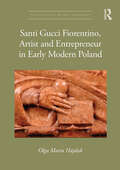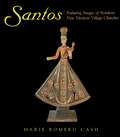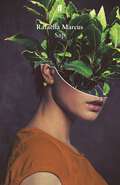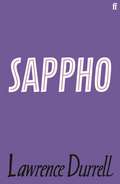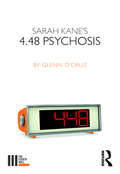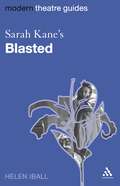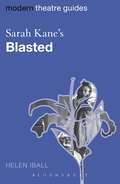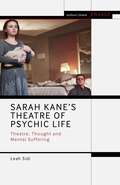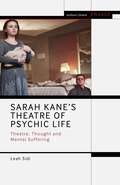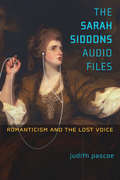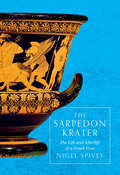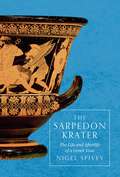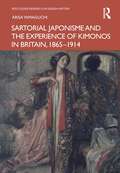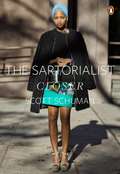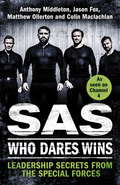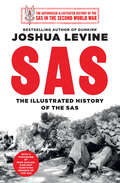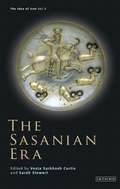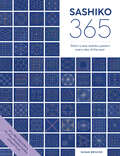- Table View
- List View
Santi Gucci Fiorentino, Artist and Entrepreneur in Early Modern Poland (ISSN)
by Olga Maria HajdukThe original research in this book analyzes the artistic activity of Santi Gucci (1533– c.1600), a Florentine sculptor active in Poland in the second half of the sixteenth century, and his workshop.Chapters examine the organization of the artistic workshop (sculpting and masonry) and the model of the artist’s functioning as an entrepreneur in Renaissance Poland, using Santi Gucci’s activity as an example. Gucci shaped the image of Polish sculpture in the sixteenth century for more than 50 years, even though his work has not yet been fully examined. The author sets Gucci’s emigration within the context of the cultural exchanges between Italy and Poland that contributed to the development of the Polish Renaissance.The book will be of interest to scholars working in art history, Renaissance studies, architectural history and economic history.
Santos: Enduring Images of Northern New Mexican Village Churches
by Marie Romero CashRichly illustrated with examples of eighteenth- and nineteenth-century art from northern New Mexico's village churches, Santos is an in-depth investigation into the artistic heritage of the New Mexican santero (saint maker). It is also an important study of northern New Mexican artisans and their craft. Along with photographer Jack Parsons, Marie Romero Cash visited every church in the region and documented, identified, and measured each santos. Together they photographed more than 500 pieces, including 19 moradas (places of worship for Penitentes) and the Archdiocese of Santa Fe Collection housed at the Museum of International Folk Art. Cash's extensive research into these formerly "anonymous" artisans fills a gap in the study of this unique form, making Santos indispensable for art historians and the general reader interested in the culture and art of the American Southwest.
São Paulo Heterotopia: Urban Spaces in Suspense / Urbane Räume in der Schwebe (Architekturen #68)
by Ulrike Böhm Katja Benfer Cyrus Zahiri (eds./Hg.)Public and private, traffic and open space, planned and spontaneous - our idea of a city is characterised by opposites. However, the contributors to this bilingual book show that these poles can also be consciously connected. The urban building blocks from São Paolo present surprisingly idiosyncratic city scenes: People dancing along the motorway, strolling through the stone archipelago, splashing around in front of the city skyline Many of the case studies are linked to the ideas of the Brazilian urban planner Francisco Prestes Maia. As early as in the 1930s, he developed concepts that combine traffic, open space and architecture - a surprisingly contemporary approach. Öffentliches und Privates, Verkehr und Freiraum, Geplantes und Spontanes - unsere Stadtvorstellung ist geprägt durch Gegensätze. Dagegen zeigen die Beitragenden in dem zweisprachigen Band, dass sich diese Pole auch bewusst verknüpfen lassen. Die Stadtbausteine aus São Paolo präsentieren unerwartet eigenwillige Stadtszenen: Tanzende entlang der Schnellstraße, Flanierende durch das Steinarchipel, Planschende vor der Stadtsilhouette Viele der vorgestellten Projekte sind verknüpft mit den Ideen des brasilianischen Stadtplaners Francisco Prestes Maia. Schon in den 1930er Jahren entwickelte er Konzepte, die Verkehr, Freiraum und Architektur zusammendenken - ein überraschend aktueller Ansatz.
Sap
by Rafaella MarcusThe bark creeps up my body like a rising sea level. I wonder what will happen when it reaches my heart.When a woman tells a lie to her girlfriend, a seed is planted that starts to grow in the darkness. Now roots are cracking through the pavement and branches are coming in at the windows. As she starts to see things that no one else can, she becomes the focus of some seriously unwanted attention.A queer urban fable about passion, power and photosynthesis, a contemporary thriller with ancient roots, Rafaella Marcus's Sap, her first full-length stage play, opened at Roundabout @ Summerhall, as part of the Edinburgh Festival Fringe, in August 2022.
Sappho
by Lawrence Durrell'A magician.' The Times'A philosophical play of ideas, exploring loss, war, and incest in Ancient Greece, by the celebrated author of The Alexandria Quartet.Lesbos, Ancient Greece. Lawrence Durrell's intricate play follows vivid characters who represent different attitudes towards the role of the individual in the world, exploring how their lofty ideals are transformed when they become victims of unforeseeable real-life circumstances. Eloquent, tragic, poetic, Durrell's parable is a powerful study of idealism in an imperfect universe, drawing vibrant parallels between the classical world and our modern existence.
Sarah Kane's 4.48 Psychosis (The Fourth Wall)
by Glenn D'Cruz"Everything passes/Everything perishes/Everything palls" – 4.48 Psychosis How on earth do you award aesthetic points to a 75-minute suicide note? The question comes from a review of 4.48 Psychosis’ inaugural production, the year after Sarah Kane took her own life, but this book explores the ways in which it misses the point. Kane’s final play is much more than a bizarre farewell to mortality. It’s a work best understood by approaching it first and foremost as theatre – as a singular component in a theatrical assemblage of bodies, voices, light and energy. The play finds an unexpectedly close fit in the established traditions of modern drama and the practices of postdramatic theatre. Glenn D’Cruz explores this theatrical angle through a number of exemplary professional and student productions with a focus on the staging of the play by the Belarus Free Theatre (2005) and Melbourne’s Red Stitch Theatre (2007).
Sarah Kane's 4.48 Psychosis (The Fourth Wall)
by Glenn D'Cruz"Everything passes/Everything perishes/Everything palls" – 4.48 Psychosis How on earth do you award aesthetic points to a 75-minute suicide note? The question comes from a review of 4.48 Psychosis’ inaugural production, the year after Sarah Kane took her own life, but this book explores the ways in which it misses the point. Kane’s final play is much more than a bizarre farewell to mortality. It’s a work best understood by approaching it first and foremost as theatre – as a singular component in a theatrical assemblage of bodies, voices, light and energy. The play finds an unexpectedly close fit in the established traditions of modern drama and the practices of postdramatic theatre. Glenn D’Cruz explores this theatrical angle through a number of exemplary professional and student productions with a focus on the staging of the play by the Belarus Free Theatre (2005) and Melbourne’s Red Stitch Theatre (2007).
Sarah Kane's Blasted (Modern Theatre Guides Ser.)
by Dr Helen IballBlasted has been labelled as one of the landmark plays of post-war British theatre, achieving its iconic status and, indeed, its notoriety, very quickly. Sarah Kane's suicide in 1999 consolidated a process of singling-out that had begun four years earlier with the 'national outrage' initiated by the media's scandalised response to the premiere of Blasted. The brutal content of the play resulted in much-quoted hostility from the critics. Academic attention to the play has begun a process of re-evaluation, debating the production and reception of the play and key issues including its status as a classic example of 'in-yer-face' drama. This guide provides a comprehensive critical introduction to Blasted, giving students an overview of the play's significance, a brief biography of Sarah Kane and a guide to socio-political background; a detailed analysis of the play's structure, style and characters; an analysis of key production issues and choices; an overview of key productions from the 1995 Royal Court premiere to today; and a chapter exploring possibilities and exercises for practical work on the play. An annotated guide to further reading highlights key secondary material including useful websites.
Sarah Kane's Blasted (Modern Theatre Guides)
by Helen IballBlasted has been labelled as one of the landmark plays of post-war British theatre, achieving its iconic status and, indeed, its notoriety, very quickly. Sarah Kane's suicide in 1999 consolidated a process of singling-out that had begun four years earlier with the 'national outrage' initiated by the media's scandalised response to the premiere of Blasted. The brutal content of the play resulted in much-quoted hostility from the critics. Academic attention to the play has begun a process of re-evaluation, debating the production and reception of the play and key issues including its status as a classic example of 'in-yer-face' drama. This guide provides a comprehensive critical introduction to Blasted, giving students an overview of the play's significance, a brief biography of Sarah Kane and a guide to socio-political background; a detailed analysis of the play's structure, style and characters; an analysis of key production issues and choices; an overview of key productions from the 1995 Royal Court premiere to today; and a chapter exploring possibilities and exercises for practical work on the play. An annotated guide to further reading highlights key secondary material including useful websites.
Sarah Kane’s Theatre of Psychic Life: Theatre, Thought and Mental Suffering (Methuen Drama Engage)
by Leah SidiSarah Kane was one of the landmark playwrights of 1990s Britain, her influence being felt across UK and European theatre. This is the first book to focus exclusively on Kane's unique approach to mind and mental health. It offers an important re-evaluation of her oeuvre, revealing the relationship between theatre and mind which lies at the heart of her theatrical project. Drawing on performance theory, psychoanalysis and neuroscience, this book argues that Kane's innovations generate a 'dramaturgy of psychic life', which re-shapes the encounter between stage and audience. It uses previously unseen archival material and contemporary productions to uncover the mechanics of this innovative theatre practice. Through a radically open-ended approach to dramaturgy, Kane's works offer urgent insights into mental suffering that take us beyond traditional discourses of empathy and mental health and into a profound rethinking of theatre as a mode of thought. As such, her theatre can help us to understand debates about mental suffering today.
Sarah Kane’s Theatre of Psychic Life: Theatre, Thought and Mental Suffering (Methuen Drama Engage)
by Leah SidiSarah Kane was one of the landmark playwrights of 1990s Britain, her influence being felt across UK and European theatre. This is the first book to focus exclusively on Kane's unique approach to mind and mental health. It offers an important re-evaluation of her oeuvre, revealing the relationship between theatre and mind which lies at the heart of her theatrical project. Drawing on performance theory, psychoanalysis and neuroscience, this book argues that Kane's innovations generate a 'dramaturgy of psychic life', which re-shapes the encounter between stage and audience. It uses previously unseen archival material and contemporary productions to uncover the mechanics of this innovative theatre practice. Through a radically open-ended approach to dramaturgy, Kane's works offer urgent insights into mental suffering that take us beyond traditional discourses of empathy and mental health and into a profound rethinking of theatre as a mode of thought. As such, her theatre can help us to understand debates about mental suffering today.
The Sarah Siddons Audio Files: Romanticism and the Lost Voice (Theater: Theory/Text/Performance)
by Judith PascoeEnglish actress Sarah Siddons (1755–1831) was an international celebrity widely acclaimed for her performances of tragic heroines.We know what Siddons looked like—an endless number of artists asked her to sit for portraits and sculptures—but what of her famous voice? In lively and engaging prose, Judith Pascoe journeys to discover how the celebrated romantic actor’s voice sounded and to understand its power to move audiences to a state of emotional collapse. The author’s quixotic endeavor leads her to enroll in a “Voice for Actors” class, to collect Lady Macbeth voice prints, and to listen more carefully to the soundscape of her own life. The Sarah Siddons Audio Files is the first full-scale attempt to address the importance of the voice in romantic culture. Bringing together archival discoveries, sound recording history, and media theory, the book shows how the romantic poets’ preoccupation with voices is linked to a larger cultural anxiety about the voice’s ephemerality. The Sarah Siddons Audio Files contributes to a growing body of work on the fascinating history of sound, and will engage a broad audience interest in how recording technology has altered human experience.
The Sarpedon Krater: The Life and Afterlife of a Greek Vase
by Nigel SpiveyPerhaps the most spectacular of all Greek vases, the Sarpedon krater depicts the body of Sarpedon, a hero of the Trojan War, being carried away to his homeland for burial. It was decorated some 2,500 years ago by Athenian artist Euphronios, and its subsequent history involves tomb raiding, intrigue, duplicity, litigation, international outrage, and possibly even homicide. How this came about is told by Nigel Spivey in a concise, stylish book that braids together the creation and adventures of this extraordinary object with an exploration of its abiding influence. Spivey takes the reader on a dramatic journey, beginning with the krater’s looting from an Etruscan tomb in 1971 and its acquisition by the Metropolitan Museum of Art, New York, followed by a high-profile lawsuit over its status and its eventual return to Italy. He explains where, how, and why the vase was produced, retrieving what we know about the life and legend of Sarpedon. Spivey also pursues the figural motif of the slain Sarpedon portrayed on the vase and traces how this motif became a standard way of representing the dead and dying in Western art, especially during the Renaissance. Fascinating and informative, The Sarpedon Krater is a multifaceted introduction to the enduring influence of Greek art on the world.
The Sarpedon Krater: The Life and Afterlife of a Greek Vase
by Nigel SpiveyPerhaps the most spectacular of all Greek vases, the Sarpedon krater depicts the body of Sarpedon, a hero of the Trojan War, being carried away to his homeland for burial. It was decorated some 2,500 years ago by Athenian artist Euphronios, and its subsequent history involves tomb raiding, intrigue, duplicity, litigation, international outrage, and possibly even homicide. How this came about is told by Nigel Spivey in a concise, stylish book that braids together the creation and adventures of this extraordinary object with an exploration of its abiding influence. Spivey takes the reader on a dramatic journey, beginning with the krater’s looting from an Etruscan tomb in 1971 and its acquisition by the Metropolitan Museum of Art, New York, followed by a high-profile lawsuit over its status and its eventual return to Italy. He explains where, how, and why the vase was produced, retrieving what we know about the life and legend of Sarpedon. Spivey also pursues the figural motif of the slain Sarpedon portrayed on the vase and traces how this motif became a standard way of representing the dead and dying in Western art, especially during the Renaissance. Fascinating and informative, The Sarpedon Krater is a multifaceted introduction to the enduring influence of Greek art on the world.
The Sarpedon Krater: The Life and Afterlife of a Greek Vase
by Nigel SpiveyPerhaps the most spectacular of all Greek vases, the Sarpedon krater depicts the body of Sarpedon, a hero of the Trojan War, being carried away to his homeland for burial. It was decorated some 2,500 years ago by Athenian artist Euphronios, and its subsequent history involves tomb raiding, intrigue, duplicity, litigation, international outrage, and possibly even homicide. How this came about is told by Nigel Spivey in a concise, stylish book that braids together the creation and adventures of this extraordinary object with an exploration of its abiding influence. Spivey takes the reader on a dramatic journey, beginning with the krater’s looting from an Etruscan tomb in 1971 and its acquisition by the Metropolitan Museum of Art, New York, followed by a high-profile lawsuit over its status and its eventual return to Italy. He explains where, how, and why the vase was produced, retrieving what we know about the life and legend of Sarpedon. Spivey also pursues the figural motif of the slain Sarpedon portrayed on the vase and traces how this motif became a standard way of representing the dead and dying in Western art, especially during the Renaissance. Fascinating and informative, The Sarpedon Krater is a multifaceted introduction to the enduring influence of Greek art on the world.
The Sarpedon Krater: The Life and Afterlife of a Greek Vase
by Nigel SpiveyPerhaps the most spectacular of all Greek vases, the Sarpedon krater depicts the body of Sarpedon, a hero of the Trojan War, being carried away to his homeland for burial. It was decorated some 2,500 years ago by Athenian artist Euphronios, and its subsequent history involves tomb raiding, intrigue, duplicity, litigation, international outrage, and possibly even homicide. How this came about is told by Nigel Spivey in a concise, stylish book that braids together the creation and adventures of this extraordinary object with an exploration of its abiding influence. Spivey takes the reader on a dramatic journey, beginning with the krater’s looting from an Etruscan tomb in 1971 and its acquisition by the Metropolitan Museum of Art, New York, followed by a high-profile lawsuit over its status and its eventual return to Italy. He explains where, how, and why the vase was produced, retrieving what we know about the life and legend of Sarpedon. Spivey also pursues the figural motif of the slain Sarpedon portrayed on the vase and traces how this motif became a standard way of representing the dead and dying in Western art, especially during the Renaissance. Fascinating and informative, The Sarpedon Krater is a multifaceted introduction to the enduring influence of Greek art on the world.
Sartorial Japonisme and the Experience of Kimonos in Britain, 1865-1914 (Routledge Research in Design History)
by Arisa YamaguchiUsing interdisciplinary research and critical analysis, this book examines experiences through (or with) kimonos in Britain during the late Victorian and Edwardian periods. Bringing new perspectives to challenge the existing model of ‘Japonisme in fashion’ and introducing overlooked contacts between kimonos and people, this book explores not only fine arts and department stores but also a variety of theatres and cheap postcards. Putting a particular focus on the responses and reactions elicited by kimonos in visual, textual and material forms, this book initiates an entirely new discussion on the British adoption of Japanese kimonos beyond the monolithic view of the relationship between the East and West. This book will be of interest to scholars working in fashion studies, British studies, Japanese studies, design history and art history.
Sartorial Japonisme and the Experience of Kimonos in Britain, 1865-1914 (Routledge Research in Design History)
by Arisa YamaguchiUsing interdisciplinary research and critical analysis, this book examines experiences through (or with) kimonos in Britain during the late Victorian and Edwardian periods. Bringing new perspectives to challenge the existing model of ‘Japonisme in fashion’ and introducing overlooked contacts between kimonos and people, this book explores not only fine arts and department stores but also a variety of theatres and cheap postcards. Putting a particular focus on the responses and reactions elicited by kimonos in visual, textual and material forms, this book initiates an entirely new discussion on the British adoption of Japanese kimonos beyond the monolithic view of the relationship between the East and West. This book will be of interest to scholars working in fashion studies, British studies, Japanese studies, design history and art history.
The Sartorialist: Closer (The\sartorialist Ser.)
by Scott SchumanAfter the enormous success of The Sartorialist, Scott Schuman is back with a completely new collection of beautiful images of the men and women who have caught his attention. His much-loved blog, thesartorialist.com, remains one of the most-read in the fashion world and continues to grow in popularity as Scott travels further and more widely. This book encompasses the diverse style and visual attitude of people as far afield as Japan, Korea, London, Milan, New York, Paris and beyond.In The Sartorialist II, Scott Schuman looks deeper and with greater breadth at human style, and the way it is expressed across the world. Always reacting to an inspirational moment, the images in this new book continue to reflect Scott's unique sensibility and vision.
The Sartorialist: Closer (The Sartorialist)
by Scott SchumanScott Schuman is back to complete his trilogy of street-style bibles. With a vibrant collection of beautiful images of the men and women who have caught his attention around the world, Schuman remains a thrilling source of urban and high-end style. From its origins on the streets of New York, his much-loved blog, thesartorialist.com is a vivid and growing hub of inspiration for fashion lovers everywhere.This collection displays the very best from the last three years of the blog. The Sartorialist: X is full of beauty, mystery and humanity.
SAS: Leadership Secrets from the Special Forces
by Jason Fox Anthony Middleton Matthew Ollerton Colin MaclachlanLife and leadership lessons from the Special Forces, from the stars of Channel 4 series SAS: Who Dares Wins - including Sunday Times bestselling author of FIRST MAN: LEADING FROM THE FRONT, Ant MiddletonAre you up to the challenge of SAS leadership? Only the best will succeed... Britain's SAS (Special Air Service) has an unparalleled reputation for soldiering excellence. Their skills and techniques have been perfected in the most demanding environments imaginable, but many of these can also be used in our everyday lives. This book takes situations all of us will experience during our lives and presents tactical lessons drawn from SAS training and battlefield experience. Its four authors - stars of the hit Channel 4 show SAS: Who Dares Wins - how their finely honed understanding of how to handle extreme challenges can be applied in any environment. Their advice on negotiation, people management, self-motivation and resilience, among other things, can transform your performance in a whole range of scenarios: from buying a house, nailing a job interview, and the experience of dealing with rejection, to maintaining a diet, or managing that pushy colleague at work.This is the ultimate guide to leadership and personal achievement.
SAS: The Illustrated History Of The Sas
by Joshua LevineThe authorised illustrated history of the SAS by the number one bestselling author of Dunkirk, Joshua Levine. With never-before-seen photographs and unheard stories, this is the SAS’s wartime history in vivid and astonishing detail.
The Sasanian Era
by Vesta Sarkhosh Curtis Sarah StewartThis latest volume in "The Idea of Iran" series concentrates on the Sasanian period. Seizing power from the previous dynasty - the Parthians - the Sasanians ruled Iran and most of the ancient Near East from 224 until 642 CE. They are particularly fascinating because of their adherence to Zoroastrianism, an ancient dualistic Iranian religion named after the prophet Zarathustra (or, in Greek, Zoroaster). The Sasanians expressed the divine aspect of their rule in a variety of forms, such as on coins, rock reliefs and silver plates, and architecture and the arts flourished under their aegis. Sasanian military success brought them into conflict with Rome, and later Byzantium. Their empire eventually collapsed under the force of the Arab army in AD 642, when Zoroastrianism was replaced with Islam.Engaging with all the major aspects of Sasanian culture, twelve eminent scholars address subjects which include: early Sasanian art and iconography; early Sasanian coinage; religion and identity in the Sasanian empire; later Sasanian orality and literacy; and state and society in late antique Iran.The volume in question arguably comprises the most complete and comprehensive treatment of the Sasanian civilization yet to be published in English.
Sashiko 365: Stitch a new sashiko embroidery pattern every day of the year
by Susan BriscoeA collection of 365 different sashiko patterns to sew - one for every day of the year. Sashiko sewing expert, Susan Briscoe, demonstrates 365 different sashiko patterns, one for each day of the year - sew all 365 to make a beautiful sashiko quilt featuring all the designs Each sashiko pattern is stitched onto a four-inch square piece of fabric making it very accessible to sew one swatch every day. You can record the date of each sample you stitch in the book to create a record of your sewing. All of the stitch patterns are illustrated with a photograph of the stitched sample showing some stitches in different coloured thread (this is used by the author to identify which stitches to do first), next to a diagram showing the stitch direction and the order of the stitches on the grid. All the patterns are sewn on four-inch fabric swatches which can then be pieced together to create the ultimate double bed sized sashiko sampler quilt. But as well as sewing the four-inch samples separately to make them into a large bed-sized quilt, the patterns can also be repeated to create larger designs over a wider surface area to make wall hangings, throws, table mats and smaller quilts - with this collection of 365 designs the possibilities are endless. Sashiko embroidery is a decorative sewing technique from Japan which was traditionally used to reinforce clothing and other textiles. It is an ideal stitch for visible mending and has become incredibly popular over the last few years. The technique of sewing horizontal and vertical stitches makes extremely attractive geometric designs that can be adapted to suit a wide range of sewing projects. Susan Briscoe is an expert in Japanese sewing techniques and has travelled to Japan numerous times. She is the author of the best-selling Ultimate Sashiko Sourcebook and runs regular workshops teaching sashiko sewing. This is the first time all of these 365 designs will appear in one book. Susan has included the Japanese name and pattern type in the text and has grouped specific design patterns together so you can see how they develop and use the collection to build your skills and knowledge of sashiko patterns.
